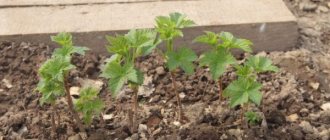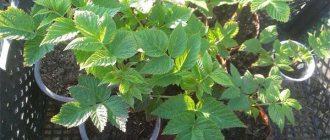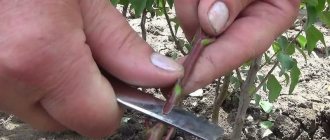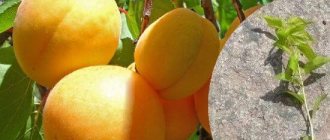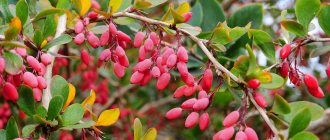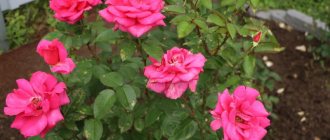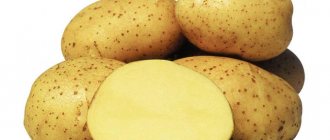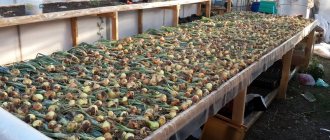Barberry is a berry that has become popular due to its taste and wide use in folk medicine. Its peculiarity is that all parts of the plant are used in various recipes - fruits, leaves, branches, roots, seeds, bark. You need to learn when to collect barberry and how to dry it in order to make the fruit as beneficial as possible for your body and health.
It is customary to collect each part of the plant separately from the others at different times and in dry weather. This is necessary in order not to harm the bush and preserve the benefits of the collected parts of the plant for a long time.
What can be used
Barberry berries are included in diets for weight loss, consumed to strengthen the immune system, and added in pickled form to fried or stewed vegetables. The fruits are used to make masks that smooth out wrinkles on the skin and remove dark circles under the eyes. Decoctions are prepared from leaves rich in ascorbic acid and carotene, which promote:
- stopping bleeding;
- eliminating nausea;
- excretion of bile.
The roots of barberry are dried and put into tea, and the infusion is used to rinse the mouth to relieve inflammation. The decoction is used for stomach cramps. Natural paint is obtained from the branches and trunk of barberry. Medicines from the bark of the bush reduce blood pressure and stop internal bleeding.
When to Harvest Different Parts of a Plant
To ensure that the leaves, wood and fruits do not lose their healing properties, they need to be harvested at certain times; they are collected at different times of the year.
Berries
Unripe barberry is dangerous to humans because it contains poison. In mid-latitudes, fruits begin to be harvested no earlier than the end of August. You can pick the berries from the bush in late autumn after frost, but overripe barberries leak juice and quickly spoil.
Roots
In the underground part of the thorny bush, most of the useful components accumulate by autumn. To prevent the plant from dying, carefully use a shovel to separate no more than 1/3 of the root shoots. They are not washed, but dried and stored in burlap or wrapped in newspapers. The next harvest of this barberry can be carried out no earlier than after 5 years.
When the bush begins to secrete sap, which in mid-latitudes occurs in the second month of spring, medicinal raw materials such as bark are prepared. It is removed from the shoots, laid out in the attic in a thin layer and turned over several times to dry everything.
Leaves
At the end of spring, the buds on the barberry open and the bush blooms. At this time, you need to cut off young branches no more than 10 cm long with tender green leaves and dry them all together, washing them from dirt.
For long-term storage, medicinal raw materials are laid out in a thin layer in the oven, first at 45, and then increasing the temperature to 60 degrees.
Features of care
Caring for barberry bushes does not require special knowledge and skills. And even if the plant is planted in the country and is remembered only periodically, it will grow and develop.
Watering barberry is necessary only at first, after planting, until the seedling takes root well. Further, it is necessary to water the bush only during periods of prolonged drought. The plant does not like excess moisture and will suffer from excessive watering.
Fertilizing can be carried out in the same way as other garden crops - in the spring with complex fertilizer, from the second half of summer - with fertilizer that does not contain nitrogen. Moreover, not every year, but once every 3-4 years! Weeding and mulching should be carried out at a young age, while the plant has poor competitiveness against weeds.
But pruning for barberry is mandatory. Firstly, sanitary - during which dried shoots are removed, poorly developed, directed deeper into the bush, broken off. Secondly, rejuvenating, when old shoots are cut out, giving the plant the opportunity to replace them with new ones.
At the same time, the formation of a barberry bush begins at a young age, the next year after planting. During this period in the spring, its crown is shortened by half or 2/3. In older age, pruning is carried out in early spring and early August.
For the winter, barberry is covered only in cold climates, and then only for up to 5 years. Then the plant can cope with wintering without shelter. Traditionally, only the base of mature bushes is covered, sprinkled with peat or leaf litter.
How do harvest times depend on the variety and region of growth?
A tree-like shrub with a spreading crown is found in the Caucasus, southern Europe, and mid-latitudes. The plant takes root without problems even in Siberia. Amur barberry is common in the Far East; its berries are harvested in November. The Dulcis variety pleases with very tasty fruits that ripen in October.
In central Russia, common barberry is harvested after the first frosts, when the bitterness disappears, and they arrive already in September.
Application in cosmetology
The vitamin composition of barberry makes it a frequent ingredient in cosmetic products - masks, lotions, creams and scrubs. You can use the fruits of the plant for these purposes at home. For example, you can wash your face with a decoction of berries or leaves in the morning to smooth and whiten your skin. You can rinse your hair with barberry broth - it will become stronger and thicker. It is useful to make nail baths from barberry juice.
How to dry barberry at home
Ripe berries of the prickly plant are washed, crumpled and rotten ones are removed, and the water is allowed to drain. After this, they need to be spread out in a thin layer on a baking sheet, which is sent to the oven, where the temperature is set to at least 40, then another 20 degrees is added.
Dried barberry fruits stop sticking together and are easily separated from each other.
Drying twigs and leaves
At the end of May or beginning of July, after rain, young shoots of shrubs up to 10 cm long are harvested along with leaves. At home, medicinal raw materials are laid out in a thin layer under a canopy to avoid direct sunlight. Dry barberry leaves in a ventilated area.
We prepare the roots
The underground part of the bush, which is dug up in the fall, is freed from soil and rotten shoots and chopped into pieces up to 15 cm long. The root sections are split and placed in a dryer heated to 50 degrees.
Fruits and seeds
The oval berries of the thorny bush are very small, their length does not exceed 12 mm. Barberry seeds, like all parts of the plant, have healing properties. The fruits are harvested without removing the seeds.
Storage duration
Dried leaves and roots do not deteriorate, do not lose their beneficial components and can be used for up to three years. Berries ground with sugar should be consumed within 6–12 months. Jam or fruit preserves can be stored for the same amount of time.
Types and varieties
The sheer number of species and varieties of barberry can be confusing, especially since they are all incredibly attractive. When choosing, you should focus on what goal you are pursuing. If you are interested in edible barberry berries, then some types are planted for this, but if you want the plants to decorate your garden or become a picturesque hedge around the site, then there are others for this. But there are species and varieties that can successfully cope with both tasks.
Common barberry (Berberis vulgaris)
The main species of the barberry genus. This is a shrub up to three meters high with gray-brown shoots, on which tripartite spines up to 2 cm long grow. The leaves are elliptical, thin, membranous, with ciliated-serrate edges, the upper side of the leaf plate is dark green, the lower side is dull, gray. green. The racemose inflorescences, up to 6 cm long, consist of brilliant yellow fragrant flowers that bloom for two to three weeks. Numerous bright red fruits reach a length of one and a half centimeters.
- Sheep: growing and caring for the garden
This species has a large number of varieties - albo-variegata with white-variegated leaves, aureo-marginata with leaves edged with a golden rim, barberry atropurpurea with red or dark purple leaves. And the berries of the seedless form of barberry asperm are very convenient to process.
There are a number of species similar to common barberry: Provençal barberry (a hybrid of common barberry and Siberian barberry), spinous - a species from the Himalayas, Canadian, Zimbold's barberry, James's barberry and Diels' barberry.
Thunberg's barberry (Berberis thunbergii)
The most beautiful of the deciduous barberries, the champion of the genus among ornamental species. The height of Thunberg barberry is from 50 cm to 1 m, its branches extend horizontally, yellowish or bright red young densely branched shoots are arched, with age they become brown or purple-brown. The spines, 1 cm long, are very thin and elastic. The leaves are elegantly shaped - oblong or obovate, small - no longer than 3 cm, bright green above and bluish below, turning bright red in autumn. Single or clustered flowers, red on the outside of the petals and yellow on the inside, bloom for one to two weeks. Coral-red shiny elliptical fruits up to 1 cm long ripen in early autumn and decorate autumn and even winter bushes for a long time.
The berries of this species contain many alkaloids and therefore taste bitter, but they are an excellent food for birds in winter. Planting Thunberg barberry and further caring for it does not cause any trouble, but the aesthetic pleasure that you will get by growing this species or its varieties on your site is beyond all expectations. Thunberg's barberry has several decorative forms: multi-flowered (pluriflora), dark purple (atropurpurea), silver-marginated (argenteo-marginata) and others. Popular varieties:
- barberry Golden Ring up to three meters high with a rounded crown, ovate leaves up to 4 cm long, dark purple-red in color with a yellow border along the edge. In autumn the leaves take on an intense red hue. The flowers, collected in bunches of 2-5 pieces, up to 1 cm in diameter, are yellow on the inside and red on the outside. Coral-red, shiny berries ripen in October;
- Red Pilar barberry is an attractive columnar-shaped variety up to one and a half meters high and a crown width of up to 45 cm with reddish-purple leaves that turn bright scarlet in autumn;
- barberry Orange Rocket is a columnar-shaped variety, reaching a height of no more than 120 cm and a width of 60 cm. Small smooth ovoid leaves on the current year's shoots are orange with a yellow border, the leaves on last year's shoots are red-purple - the bush looks incredibly attractive against the backdrop of spring and summer greenery. In autumn the leaves turn different shades of red;
- Kornik is a deciduous shrub, one and a half meters tall, with pale green leaves covered with random creamy-white spots of various shapes, as if splashed with paint. In autumn, the green background of the leaves turns scarlet red. The variety looks great next to roses, conifers and other varieties of barberry.
Ottawa barberry (Berberis x ottawensis)
It is an ornamental hybrid between the atropurpurea form of common barberry and Thunberg barberry. This is one of the most spectacular representatives of the genus: from one and a half to two meters in height, it looks like an enlarged copy of the Thunberg barberry, but the color of the leaves is closer to the purple-leaved form of the common barberry - dark pink-violet, almost black in the sun, color. In autumn, the leaves turn crimson and blaze for a long time in a joyless gray garden.
Ottawa barberry is winter-hardy, easy to care for and grows very quickly. Popular varieties:
- Auricoma - up to 2.5 m high, rounded leaves, up to 5 cm long, bright red in spring and summer, orange in autumn, red-yellow flowers up to 1 cm in diameter collected in racemes up to 5 cm long, bright red fruits;
- Superba - up to 4 m high, leaves are round, 3 to 5 cm long, dark red with a bluish bloom, in autumn they turn into various shades of orange and red. Yellow-red flowers are collected in clusters, the berries are red;
- Silver Miles - This variety needs to be viewed from afar as it doesn't look attractive up close: purple leaves with dirty gray smudges. From a distance, the bush acquires a lilac hue due to the fusion of gray and purple flowers.
In addition to the listed types of barberry, Juliana, Bean, Tischler, Morrison, Wilson barberries, greenish, willow, multi-flowered, oriental, Iberian, reticulate, similar, bluish-white, boxwood, notched or unedged, large-thorned, provincial, spring are grown in culture around the world , Ili, coin, Korean, Tibetan, Siberian, transparent, round-serrated, twisted, Amur, Turkmen, whole-edged, oblong, round-fruited, Asian and many others.
Where and how to use blanks correctly
Tincture of berries is used to treat gout and scurvy, relieve stomach colic, relieve constipation, inflammation of the eyes, and is also used as an antiseptic.
Decoctions and infusions are prepared from the root, which help:
- Stop the bleeding.
- Improve the functioning of the gallbladder.
- Improve metabolism.
The flowers are poured with boiling water and drunk as tea for a cold. A decoction is prepared from the dry leaves of the bush, which is used to narrow dilated blood vessels and speed up blood circulation.
Barberry is used to produce drugs that reduce blood pressure and normalize heartbeat. Tablets from the berries are prescribed for hepatitis, to remove stones from the gall bladder. Dried fruits are used as a seasoning and added to various dishes.
The bark of the shrub is crushed, placed in hot water, and an infusion of 50 ml is taken for stomach pain, cystitis, and impaired kidney function.
Since childhood, we have all been familiar with these small red berries, mainly from candies and lemonade. But, besides this, barberry is widely used in cooking and is used as an effective medicine. To preserve barberry's high taste and medicinal qualities, you need to know how and when you begin to collect the fruits, as well as the leaves, roots and bark.
Useful properties and medicinal effects of berries
The healing properties have been known since the times of Ancient Greece. For the treatment and prevention of diseases of the liver, kidneys, and bile ducts, a tincture of barberry leaves is used. It acts as a choleretic and anti-inflammatory agent. The bark, as well as roots and leaves, of the shrub contain 11 alkaloids, in particular berberine, which helps reduce heart rate and lower blood pressure.
They make a tincture that helps with bleeding, inflammation and colds and even fever. For gastritis, take a drink made from barberry berries; their juice has an antimicrobial and antipyretic effect.
The fruits are used to remove toxins and generally cleanse the body; they help slow down the aging process.
Alcohol tincture of barberry is sold in pharmacies; doctors recommend it for hepatitis, uterine bleeding and cholelithiasis. The drug Berberine is also produced on its basis. In cosmetology, it is used in the form of decoctions and various tinctures, as well as for making masks. Barberry is widely used in cooking, in particular, it is an integral ingredient for preparing Uzbek pilaf. Liqueurs, candies, wines, jams, preserves, jellies, lemonades, syrups and various seasonings are also prepared from its berries.
Use in cooking
Barberry fruits have found their place in cooking. The product is used for the production of syrups, jellies, juices, compotes, preserves and jams.
As a seasoning that adds sourness, dried and crushed barberries are added to meat dishes. To enhance the flavor, the product is placed in pilaf and kupaty (raw sausages).
Sour fruits are used in the production of liqueur and wine. Unripe berries are marinated and salted.
How to brew barberry?
Tea with barberry is very beneficial for the body. This drink has a calming, choleretic, antimicrobial and antipyretic effect.
There are several ways to brew barberry:
- Pour a couple of tablespoons of fresh berries with water (you will need 500 ml). The berries should be cooked in a water bath for 20 minutes. During cooking, some of the liquid will boil away. Therefore, after a specified period of time, the drink must be filtered, adding enough water so that the volume is again equal to 500 ml.
- Steam a teaspoon of barberry with boiling water (250 ml) and leave to brew for 10 minutes. The drink can be drunk without diluting with water. This tea has a rather sour taste, so you can add honey or granulated sugar to it.
- Pour a teaspoon of fresh berries into a glass of boiling water. The container containing the liquid should be wrapped. The drink is infused for 7 minutes. Then you need to add honey and lemon juice (a teaspoon each) to the tea.
- Pour a glass of boiling water over a teaspoon of dried fruits and add a teaspoon of sugar. Brew for 10 minutes. Filter the drink. You should drink the liquid warm after eating.
You can also brew black tea using barberry berries. To do this, you need to boil 600 ml of water. Wash and dry dried fruits. Add a tablespoon of black tea and 1.5 tablespoons of barberry to the teapot. Pour boiling water over the contents of the container and let it brew for 15 minutes. The finished tea is poured into mugs, where you can also add honey for sweetness.
How to make compote?
Barberry compote perfectly quenches thirst and also has a beneficial effect on the body, strengthening the immune system. Berry compote also lowers blood pressure and normalizes digestive activity.
To make barberry compote, you need:
- Carefully sort 200 grams of fresh berries (remove leaves and stems), then fill completely with water and wash. The liquid will have to be changed several times to better clean the product from dust and dirt.
- Place clean fruits in a deep saucepan, add 100 grams of granulated sugar and pour in 800 ml of water.
- As soon as the liquid boils, the fire must be kept low and the drink simmered until the berries give the liquid their taste, smell and color.
- If necessary, you can add a little more sugar. After this, the container with compote should be wrapped in a warm blanket and left to infuse for 30 minutes.
- After the specified time, the barberry compote can be poured into glasses and served.
This compote can be preserved for the winter. To do this, the finished hot drink is poured into sterilized jars and hermetically sealed.
How to infuse berries?
Alcohol tincture of barberry is used to treat many diseases (for example, hepatitis, cholecystitis and cholelithiasis). In addition, the drink improves appetite and normalizes the activity of the gastrointestinal tract.
You can infuse barberry berries with any alcohol-containing base. For these purposes, you can use vodka, alcohol or moonshine. Also, some cooks make barberry tincture with cognac.
On vodka
To infuse berries with vodka, you need:
- Wash 200 grams of barberry, dry it and put it in a container. Pour 500 ml of vodka over the fruits.
- Close the container and put it in a dark and well-heated place for 15 days. The liquid should be shaken thoroughly every three days.
- After the specified period of time, you need to put 3 clove buds, a cinnamon stick, a pinch of cumin and orange zest into the infusion.
- Next you need to repeat everything the same as in stage 2.
- Filter the composition and pour into a clean container.
- In a separate bowl, mix 100 ml of bottled water and 200 g of granulated sugar. Cook over low heat for 7 minutes, regularly skimming the foam from the surface of the syrup. The composition should cool to room temperature.
- Mix the syrup with the infusion, distribute into bottles and put in a cool place for four days.
The strength of barberry tincture is 26 revolutions. The drink can be stored for no more than 3 years. It is recommended to serve it with light snacks or desserts.
On moonshine
To make barberry tincture using moonshine, you need:
- Carefully sort through the fruits, leaving only the ripest and whole ones in the amount of 150 grams. Then the berries need to be washed and crushed.
- Place barberry in a glass container and pour in 2.5 liters of moonshine. Close the bottle and place in a dark place. Air temperature - +28 degrees.
- The liquid is infused for 15 days. The drink needs to be shaken daily.
- First, the liquid should be passed through a sieve, and then through a piece of cotton gauze.
- Add 150 grams of honey to the tincture and stir. After this, the drink must be poured into a clean bottle.
The barberry tincture should stand for three more days in a dark and cool room. After this you can taste it.
On alcohol
To make barberry tincture with alcohol, it is recommended:
- Place one kilogram of fruit in a bag and put it in the freezer for two days. After this, the berries need to be rinsed in warm water and placed in a jar. You also need to add 5 grams of vanilla sugar and a cinnamon stick.
- Dissolve 400 grams of linden honey in 400 ml of bottled water. Next, pour the mixture into the rest of the ingredients.
- Pour 800 ml of alcohol there. Close the container and put it in a dark and warm room for 60 days. The contents of the jar must be shaken daily.
- After the allotted period of time, the liquid should be removed from the sediment. The berries that remain at the bottom should be covered with sugar (100 grams) and put in a dark and warm place for 5 days. Drain the resulting berry syrup.
- After this, the berry syrup must be mixed with the alcohol infusion, which was previously removed from the sediment. The resulting liquid is filtered.
Pour the tincture into bottles and store in a cool place for 6 months.
Existing contraindications
It is necessary to collect only ripe berries that are red or reddish-brown in color. Unripe barberry berries are poisonous. It has the property of stimulating muscle activity, so it is prohibited to use it during pregnancy - there is a risk of miscarriage. Its use is not recommended during lactation.
In addition, the berries have a strong sedative (calming) effect. Consumption of large quantities of fruits or medicines based on it leads to poisoning, severe dizziness and nausea, swelling, cramps and nosebleeds. It is prohibited to take berries and barberry-based medicines for liver cirrhosis.
When to collect barberry
Fruits should be picked only when they are ripe - green berries can cause poisoning. Harvesting times depend on the growing area and variety.
The beneficial properties of barberry have been known since the times of Ancient Mesopotamia. The plant is winter-hardy and heat-resistant, and can also thrive in poor soils, which is why it is successfully grown in most regions of our country.
Beneficial and medicinal properties of barberry
The honey-bearing and medicinal plant has many healing properties and is very actively used for the preparation of medicines.
Fresh and dried berries
Barberry berries are considered a fairly low-calorie and completely dietary product, and per 100 g of this plant material there are only 29 kcal. The fruits of the crop are distinguished by sufficient content:
- carotenoids represented by xanthophyll, lutein, chrysanthemaxanthin, zeaxanthin, auroxanthin, flavoxanthin and capsanthin;
- carbohydrates;
- tannins;
- pectin substances;
- ash;
- organic acids;
- macro- and microelements;
- vitamins “E”, “C” and beta-carotene.
Freshly squeezed juice has antipyretic, antimicrobial, hemostatic properties, and is also used in removing toxins from the body and general cleansing, aimed at slowing down the aging process. Fully ripened berries are widely used in the treatment of:
- liver and kidney diseases;
- rheumatism;
- inflammatory processes of the bladder.
The presence in the fruits of a fairly high content of the alkaloid berberine, which has pronounced choleretic and many other properties, allows the berries to be used to get rid of alcohol and nicotine addiction.
Useful properties of barberry (video)
Healing properties of barberry bark
The beneficial and medicinal properties of the plant bark are due to its chemical composition, in particular the presence of:
- vitamins “C”, “E” and “K”;
- malic acid;
- citric acid;
- carotenoids;
- alkaloids;
- resinous substances;
- tannins.
Decoctions from the bark are used in the treatment of diseases of the female genital area. Such medicinal raw materials are collected at the stage of active sap flow, and then dried in warm rooms with good ventilation or in dryers at a temperature range of 40-50°C.
What are the benefits of barberry root and leaves?
Not only the dried leaf, but also the fresh leaf of the street crop has medicinal properties. The leaves and roots of barberry are characterized by the content of:
- berberine;
- oxyacanthin;
- palmatina;
- columbamine;
- iatroricin.
The tincture, which is prepared using the root, stems and bark, is used to cure bleeding, inflammation and colds.
Harvesting method
The dug up roots are carefully shaken off soil and other impurities, while removing blackened and rotten parts. The most valuable part of the root is the bark; it easily peels off when cutting the roots. In order not to lose valuable raw materials, burlap is placed when cutting. Washing in water is not allowed, since berberine (the main medicinal substance) is highly soluble in water and is therefore lost during washing. The roots are dried in a well-ventilated area, under canopies or in dryers at a temperature of 45–50°C. The color of the dried roots when broken is lemon-yellow. The taste of the raw material is bitter, the smell is weak and peculiar.
The bark is collected during the period of sap movement, when it is easily removed. Make circular cuts with a knife, at a distance of 10–15 cm from one another, connect longitudinally and remove the bark.
Barberry leaves are harvested in the budding and flowering phase, then dried. Collecting damaged or rusty leaves is not allowed. The smell of the leaves is peculiar, the taste is sour.
Shelf life of leaves is 2 years, roots are 3 years.
When and how to properly collect barberry leaves and fruits
Barberry berries can be collected already in the last ten days of August, which allows you to obtain fruits with high medicinal properties. Barberry that hangs on the bushes until mid-September will lose its medicinal qualities and is unsuitable for collection for this purpose.
Drying is done under sunlight or in a well-ventilated area. The root and leaves need to be dried in the shade. Plant raw materials can be stored for a couple of years. Properly dried fruits darken and take on a highly wrinkled appearance, without releasing juice when pressed. Harvesting roots should be done in late autumn. You need to dry the raw materials by laying them out in a thin layer on cardboard or fabric, which are placed in the attic.
Freezing
You can store strawberries in the freezer for up to 1 year, but since this berry consists of 90% water, there is a risk that after complete defrosting it will lose its shape.
Before freezing, remove the sepals, wash and dry the berries. Strawberries can be frozen like this:
- Entirely. In this case, you can simply serve it on the table or use it for chocolate fondue. Since thawed berries are softer than regular ones, they are more difficult to cut into neat slices, but they are easy to mash into puree. To protect the preparations from becoming soggy, you can dip them in yogurt or melted chocolate in advance - you will get a ready-made candy.
- Sliced into slices. Neat pieces are well suited for decorating baked goods and other desserts. In addition, in this case the strawberries will freeze more evenly and faster.
- In the form of puree. It is used for smoothies or cocktails, as a filling for baked goods, etc. Even soft berries are suitable for this preparation.
Whole berries or slices can be placed in freezer-safe plastic or glass containers or ziplock bags. To store puree, use ice or ice cream molds, as well as portion cups.
You can make many desserts from defrosted puree.
Prepared strawberries can be poured with sugar syrup before freezing. It helps to better preserve the taste, aroma and shape of the fruit, but in this case they turn out to be very sweet, which not everyone likes. In addition, it will be more difficult to use part of the workpiece.
To prepare the syrup, dilute sugar with water in a 1:1 ratio. Chill the mixture in the refrigerator, then pour over the berries so that they are completely covered. This syrup can also be added to puree; in this case, about 4 parts of sugar are used for 5 parts of berries.
You can also store strawberries in pectin syrup - it keeps the shape of the berries worse, but does not make them too sweet. The proportions for its preparation should be indicated on the packaging.
If you plan to store strawberries without syrup, first arrange the berries in a single layer on a tray and freeze for several hours. Only then transfer them to a container, otherwise they will stick together. Leave about 1.5-2 cm of free space - when the berries freeze, they expand.
To prevent the berries from freezing, first freeze each one separately.
The berries need to be defrosted gradually in the refrigerator. Rapid defrosting, such as in the microwave, will make them too soft. It is advisable to eat them while still cold.
Barberry tea: recipe and features of use
Popular in many countries, barberry tea is extremely healthy. This drink perfectly quenches thirst and helps eliminate nervous tension, helps strengthen the heart muscle, and also removes toxins and slows down the aging process. As practice shows, regular consumption of the drink will balance the functioning of the thyroid gland and is characterized by a choleretic, as well as anti-inflammatory and antipyretic effect. There are different recipes for its preparation, but the following is recommended:
- First thoroughly rinse the cup with boiling water;
- pour a teaspoon of fruits or leaves, which can be either dry or fresh;
- pour boiling water and leave covered for about ten minutes.
Adding a small amount of floral liquid honey will add a pleasant sweetness to barberry and further enhance its beneficial properties.
Terms and conditions of storage
To keep barberries fresh, just place the fruits in a glass container, sprinkle with granulated sugar and put in the refrigerator. In this form, the crop will not lose its beneficial properties and will be suitable for consumption until winter.
The most common method of harvesting barberry is drying. The following methods are used for this.
Outdoor drying:
- Ripe, but not overripe fruits are collected, carefully sorted and washed.
- The washed berries are evenly laid out on clean napkins or cotton towels to allow excess moisture to be absorbed.
- The fruits, dried in this way, are distributed onto baking sheets or trays and covered with gauze or fine mesh to prevent access to insects and birds.
- Containers with berries are placed in a warm, well-ventilated room, but not in the sun, since exposure to sunlight destroys vitamins and many other useful compounds in the product.
- To ensure uniform drying, the fruits are stirred regularly.
- The readiness of barberry is determined by the absence of a sticky layer on the shell of the berries.
Oven drying:
- The berries, dried from moisture, are laid out in 1 layer on a baking sheet and placed in the oven, preheated to 40-50°C.
- When the juice stops secreting, the temperature is raised to 60°C and kept in the oven until fully cooked, usually no more than 2.5 hours.
In a fruit dryer. The method is almost identical to the previous one:
- The berries are kept at 50°C for 3 hours, after which the temperature is increased by 10°C and brought to full readiness.
- Well-dried berries do not release juice and have a characteristic gloss.
The harvested berries are poured into glass or plastic jars and tightly closed with a lid. Properly dried barberry can be stored for 3 years. In breathable containers, for example, in paper boxes or bags, it does not deteriorate even longer.
Some contraindications
Despite the large number of indications for use, as well as the pronounced therapeutic and preventive effect, it is important to remember some contraindications:
- It is not recommended to treat and prevent barberry during pregnancy, which is due to the ability of this culture to have a pronounced stimulating effect on muscle tissue and provoke premature birth;
- you should refrain from taking such folk remedies while breastfeeding;
- a contraindication for use is the use of sedatives, which is explained by the powerful calming effect of barberry;
- significant harm to the body can be caused by simply overeating berries or overdosing on medications, which often results in side effects such as dizziness, nausea, convulsions, nosebleeds and severe renal failure;
- Great care should be taken when taking barberry-based drugs if you have a history of diabetes mellitus;
- barberry is not recommended for consumption by children under twelve years of age.
Poisoning can be caused by eating unripe berries containing significant amounts of toxic substances. Absolute contraindications are liver cirrhosis and severe forms of hepatitis.
Popular folk recipes based on barberry
Only a properly prepared medicinal product, prepared in accordance with the dosage, will allow you to obtain the maximum therapeutic effect:
- for bronchitis, chronic cough, pneumonia and colds, you need to pour a tablespoon of fruit into a glass of water and boil for a quarter of an hour. The resulting decoction is filtered and diluted with boiled water at room temperature in a one to one ratio. You need to take 50 ml of the decoction. three times a day;
- To get rid of attacks of nausea, diarrhea and stomach cramps, a decoction of the leaves is used. For this purpose, you need to pour 30 g of plant material with a couple of glasses of boiled water and boil for a quarter of an hour. The resulting medicinal decoction is filtered through cheesecloth and diluted with boiled water in a one-to-one ratio. You need to take a tablespoon every six hours;
- To eliminate inflammatory processes in the mucous membrane of the mouth or gums, it is recommended to prepare a decoction of the root. A tablespoon of crushed root should be poured with a couple of glasses of water and boiled for a couple of minutes, then left for half an hour and strained. Add to rinse water.
It is very important to use only high-quality and properly collected plant materials. It is also important to follow the technology for preparing folk remedies and take them correctly. Before using barberry for medicinal purposes, you must consult a doctor.
Barberry for diseases
Methods for storing apple fruits in basements and cellars
Barberry and products based on it have different effects on the course of various diseases. Therefore, before consuming barberry compotes, infusions, decoctions, etc., it is advisable to consult with your doctor.
Hypothyroidism
With a long-term and persistent lack of thyroid hormones, experts allow the consumption of barberry berries, but only in small quantities, so as not to aggravate the condition.
Uterine bleeding
For uterine bleeding caused by menstruation or in the postpartum period, it is allowed to use barberry tincture. To prepare it, you need to pour 20 grams of leaves with 100 milliliters of vodka and leave for 15 days in a warm place. As soon as the drink turns dark yellow and acquires a sour taste, the tincture is ready. Take 30 drops three times a day. The course of treatment is 2 weeks.
Oncology
For oncology, traditional medicine experts advise using barberry infusion based on the roots and bark of the plant. This medicine acts as an additional treatment that will help stop the malignant process in the body.
High blood pressure
Barberry is able to lower high blood pressure due to the vasodilating effect inherent in these fruits. The berries also contain ascorbic acid, which helps strengthen the walls of blood vessels and prevent their fragility. In addition, barberry restores vascular tone, which has a positive effect on blood pressure.
For high blood pressure, take an infusion of barberry. To make it, you need to pour a tablespoon of plant flowers into 300 ml of water. The liquid is boiled for 10 minutes and then infused for 3 hours. The finished drink must be filtered.
Take a tablespoon before meals. The course of treatment lasts 30 days.
Cold
For colds, flu, and also to strengthen the immune system, take a decoction of barberry berries. For these purposes, the fruits are used to prepare fruit drinks, compotes, jam or preserves.
Diabetes
The product contains a special substance - the alkaloid berberine, which reduces blood sugar levels in patients with diabetes. In addition, the substance controls the disease, preventing it from developing.
When treating diabetes, you can consume not only the fruits, but also the flowers of the plant in the form of infusions. These parts of barberry contain malic acid and sugar, which reduce the thirst characteristic of this disease.
To prepare a berry infusion, mix a tablespoon of chopped fresh berries with 2 tablespoons of dried fruits, and then pour a glass of boiling water. Leave for 3 hours. Take 100 ml 3 times a day.
To make a flower infusion, you will need to pour a teaspoon of inflorescences into 200 ml of boiling water and boil for 10 minutes. Filter the finished broth. The medicine is taken one tablespoon 3 times a day after meals.
Barberry is an excellent medicine in the treatment of many serious diseases. The product contains a lot of vitamins, minerals and other equally important beneficial substances that have a beneficial effect on human health in general. In addition, the berries of the plant are widely used in cooking. The fruits are valued by chefs as a tasty and aromatic seasoning, as well as a base for drinks and desserts.
Below you can watch a video about the benefits of barberry.
How to collect barberry (video)
The medicinal and healing properties of barberry are truly unique. Any part of such an unusually beautiful and unpretentious plant contains a significant amount of substances beneficial to the human body. However, you must strictly follow the rules for collecting and preparing plant materials, as well as follow the basic rules when preparing or consuming medicines using barberry.
- Author: Maria Sukhorukikh
Rate this article:
- 5
- 4
- 3
- 2
- 1
(0 votes, average: 0 out of 5)
Share with your friends!

